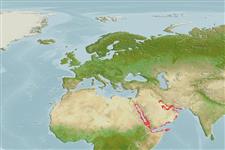Classification / Names
Common names from other countries
Main reference
Size / Weight / Age
Max length : 36.2 cm SL male/unsexed; (Ref. 95256); common length : 40.0 cm TL male/unsexed; (Ref. 5450); max. reported age: 19 years (Ref. 3625)
Length at first maturity
Lm 26.4 range ? - ? cm
Environment
Marine; brackish; reef-associated; depth range 2 - 20 m (Ref. 9710)
Climate / Range
Tropical, preferred 26°C (Ref. 107945); 32°N - 10°N, 33°E - 65°E (Ref. 95256)
Distribution
Western Indian Ocean: Red Sea (Israel, Egypt, Eritrea, Saudi Arabia), Persian Gulf (Bahrain and Kuwait), off southern Oman (not Gulf of Oman); presumably along the whole southern coast of the Arabian Peninsula, also Iran to Pakistan.
Countries | FAO areas | Ecosystems | Occurrences | Introductions
Short description
Dorsal
spines
(total): 11;
Dorsal
soft rays
(total): 12-15;
Anal
spines: 3;
Anal
soft rays: 10 - 11. This species is distinguished from its congeners by the following set of characters: 2 conspicuous vertical black bars across the head, with the first bar from occiput through eye and across cheek to rear end of maxilla. while the second bar is from nape to opercle; colour of dorsal and caudal fins yellow, without dense black margin of dorsal-fin or narrow black edge along rear margin of caudal fin; scale rows from 5th dorsal fin spine to lateral line 5 ½ or 6 ½ ; base of dorsal and anal fins are scaly; naked interorbital area and preopercle flange; along each side of upper jaw with 2 rows of molars, with the outer molar teeth row extending to rear end of both jaws; basal width of incisor teeth (usually 6) at front of upper jaw smaller, 0.7?0.8 mm for 15 cm SL fish and 2.2?2.5 mm for fish of 34 cm SL, respectively; D XI,12?15, no elongated spines; A III,10?11, with the 2nd and 3rd anal-fin spines subequal and not enlarged (Ref. 95256).
IUCN Red List Status (Ref. 115185)
Threat to humans
Harmless
Human uses
Fisheries: minor commercial
More information
ReferencesAquacultureAquaculture profileStrainsGeneticsAllele frequenciesHeritabilityDiseasesProcessingMass conversion
Tools
Special reports
Download XML
Internet sources
Estimates of some properties based on models
Phylogenetic diversity index
PD50 = 0.5000 many relatives (e.g. carps) 0.5 - 2.0 few relatives (e.g. lungfishes)
Trophic Level
3.4 ±0.43 se; Based on food items.
Resilience
Medium, minimum population doubling time 1.4 - 4.4 years (K=0.18; tmax=19)
Vulnerability
Moderate vulnerability (37 of 100)
Price category
